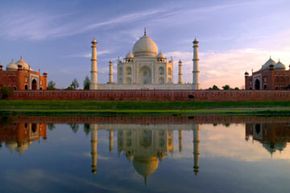Traditional Indian Arts and Architecture
Architecture and the arts in India display a devotion to gods and goddesses, oral histories and storytelling, and romantic love. India is a virtual museum of architecture dating back thousands of years, and many of its most magnificent structures excel because of their detailed carvings and stonework, as well as intricate tiling, much of it handed down through artisans from generation to generation. A combination of figures and styles from Hindu and Islamic tradition decorates temples, public buildings and residences grand and small, and there are Buddhist shrines dating to the 2nd century [source: Encyclopaedia Britannica].
A contemporary Indian style also has developed in the cities and in the Western world and it borrows the arches and vibrant colors of the traditional and combines them with 21st century modern architecture and interior design. Feng shui, the art of using spirituality to determine placement of building elements like doors and windows, as well as furniture and décor, is an ancient practice that saw a revival and international popularity in the 20th century.
Advertisement
One of India's and the world's most well-known architectural masterpieces is the 17th-century Taj Majal, and although it is a traditional gem, it is really a singular and nontraditional monument because it was built as a memorial to a person and not a god. Emperor Shah Jahan spent about 20 years and a great deal of his wealth constructing the Taj Mahal, a classic in Muslim art designed to entomb and pay homage to the emperor's wife, who died giving birth to the couple's 14th child [sources: UNESCO; PBS].
Dance, drama and musical performances often retell stories from India's classical literature and religious traditions. Famous Indian literature includes the famous epic adventures "Mahabharata" and "Ramayana" -- the world's longest poem -- each about 2,000 years old. Most writings tell the tale of mythic kings or Hindu gods and carry moral lessons to live by even in modern times [source: Encyclopaedia Britannica].
About 1,000 movies are made in India each year, earning the center of filmmaking, Mumbai (or Bombay) the nickname "Bollywood" [source: Encyclopaedia Britannica]. Movies are shown throughout the country, from rural to urban areas and in many languages, but almost all have a similar look and story line with big name Indian stars, fantastic romances and elaborate song-and-dance numbers. Most of the films also borrow heavily from tradition and re-create epic scenes from history of mythology while adding contemporary characters and settings. Bollywood movies are some of the most recognizable forms of Indian entertainment in international filmmaking.
For a closer look at some of the traditions, tastes and beliefs of India, see the next page.
Related Articles
Sources
- Al Jazeera. "Witness: Hair India." AlJazeera.net. June 12, 2011. (July 28, 2011) http://english.aljazeera.net/programmes/witness/2010/01/2010127121316920743.html
- BBC. "Religions: Introduction to Hinduism." Sept. 29, 2009. (July 29, 2011) http://www.bbc.co.uk/religion/religions/hinduism/ataglance/glance.shtml
- Carr, Karen. "Indian Food." HistoryforKids.org. 2011. (July 28, 2011) http://www.historyforkids.org/learn/india/food/
- Central Intelligence Agency (CIA). "CIA Factbook: India." CIA.gov. 2011. (July 28, 2011) http://www.cia.gov/library/publications/the-world-factbook/geos/in.html
- Encyclopaedia Britannica. "India." Britannica.com. 2011. (July 27, 2011) http://www.britannica.com/EBchecked/topic/285248/India
- Encyclopaedia Britannica. "Race: India's Caste System." 2011. (Aug. 2, 2011) http://www.britannica.com/EBchecked/topic/488030/race/234687/Indias-caste-system
- Encyclopaedia Britannica. "Sari." Britannica.com. 2011 (July 28, 2011) http://www.britannica.com/EBchecked/topic/524328/sari
- Encyclopaedia Britannica, Student Edition. "India: Arts and Literature." 2011. (July 28, 2011) http://kids.britannica.com/comptons/article-202411/India
- Encyclopaedia Britannica, Student Edition. "India: Family." 2011. (July 28, 2011) http://kids.britannica.com/comptons/article-285885/India
- Encyclopaedia Britannica. "Tonsure." Britannica.com. 2011 (July 28, 2011) http://www.britannica.com/EBchecked/topic/599380/tonsure
- Discovery Fit & Health. "What is the principle behind ayurvedic medicine?" Curiosity.com. 2011. (July 30, 2011) http://curiosity.discovery.com/question/what-principle-behind-ayurvedic-medicine
- Food India. "Paan (Betel Leaf Chew)." Food-India.com. 2011. (Aug. 2, 2011) http://www.food-india.com/ingredients/i026_i050/i028.htm
- Giridharadas, Anand. "With India's New Affluence Comes the Divorce Generation." The New York Times. Feb. 19, 2008. (Aug. 2, 2011) http://www.nytimes.com/2008/02/19/world/asia/19iht-divorce.1.10178712.html
- Government of India, Ministry of Home Affairs. "Census of India: Religion." 2001. (July 30, 2011) http://censusindia.gov.in/Census_And_You/religion.aspx
- Henderson, Mark. "India's Caste System Descended from Two Tribes "Not Colonialism." The Sunday Times. Sept. 24, 2009. (Aug. 2, 2011) http://www.timesonline.co.uk/tol/news/science/genetics/article6846424.ece
- Hindustan Times. "Indian Brides Cast Off Red for Purple, Pink." HindustanTimes.com. Sept. 23, 2010. (July 28, 2011) http://www.hindustantimes.com/Indian-brides-cast-off-red-for-purple-pink/Article1-603630.aspx
- Kraig, Bruce. "Hidden India: The Kerala Spicelands: Spices." PBS.org. 2011. (July 28, 2011) http://www.pbs.org/hiddenindia/spices/index.htm
- Lyn, Tan Ee. "High Prevalence of Child Marriage in India." Reuters.com. March 10, 2009. (July 29, 2011) http://www.reuters.com/article/2009/03/10/us-marriage-child-odd-idUSTRE5295SA20090310
- Malhotra Hora, Reenita. "Diwali, India's Festival of Light." National Geographic Kids. 2011. (July 29, 2011) http://kids.nationalgeographic.com/kids/stories/peopleplaces/diwali/
- Public Broadcasting Service (PBS). "Taj Mahal: Memorial of Love." 2011. (July 29, 2011) http://www.pbs.org/treasuresoftheworld/a_nav/taj_nav/main_tajfrm.html
- Society for the Confluence of Festivals in India (SCFI). "Holi: Let the Colours Shower Joy." 2011. (July 30, 2011) http://www.holifestival.org/
- Tea Board of India. "About Tea." 2011. (Aug. 2, 2011) http://www.teaboard.gov.in/inner1.asp?param_link_id=31030
- The Times of India. "Oscars: Eight on Ten for Slumdog Millionaire." Feb. 23, 2009. (July 29, 2011) http://timesofindia.indiatimes.com/home/specials/oscars/Oscars-Eight-on-ten-for-Slumdog-Millionaire/articleshow/4173337.cms
- Tivedi, Tanvi. "Real Men Do Cook!" The Times of India. July 20, 2011. (July 29, 2011) http://timesofindia.indiatimes.com/life-style/relationships/man-woman/Real-men-do-cook/moviereview/8678205.cms
- UNESCO World Heritage Center. "World Heritage List: Taj Mahal." 2011. (July 29, 2011) http://whc.unesco.org/en/list/252
- Vaid, Divya. "Caste and Class in India: An Analysis." Yale University Department of Sociology. September 2007. (Aug. 2, 2011) http://www.yale.edu/ciqle/CIQLEPAPERS/CasteandClass.Vaid.pdf
- Yale Peabody Museum of Natural History. "Dabba or Tiffin Lunch Pail." 2011. (July 29, 2011) http://peabody.yale.edu/education/dabba-or-tiffin-lunch-pail
